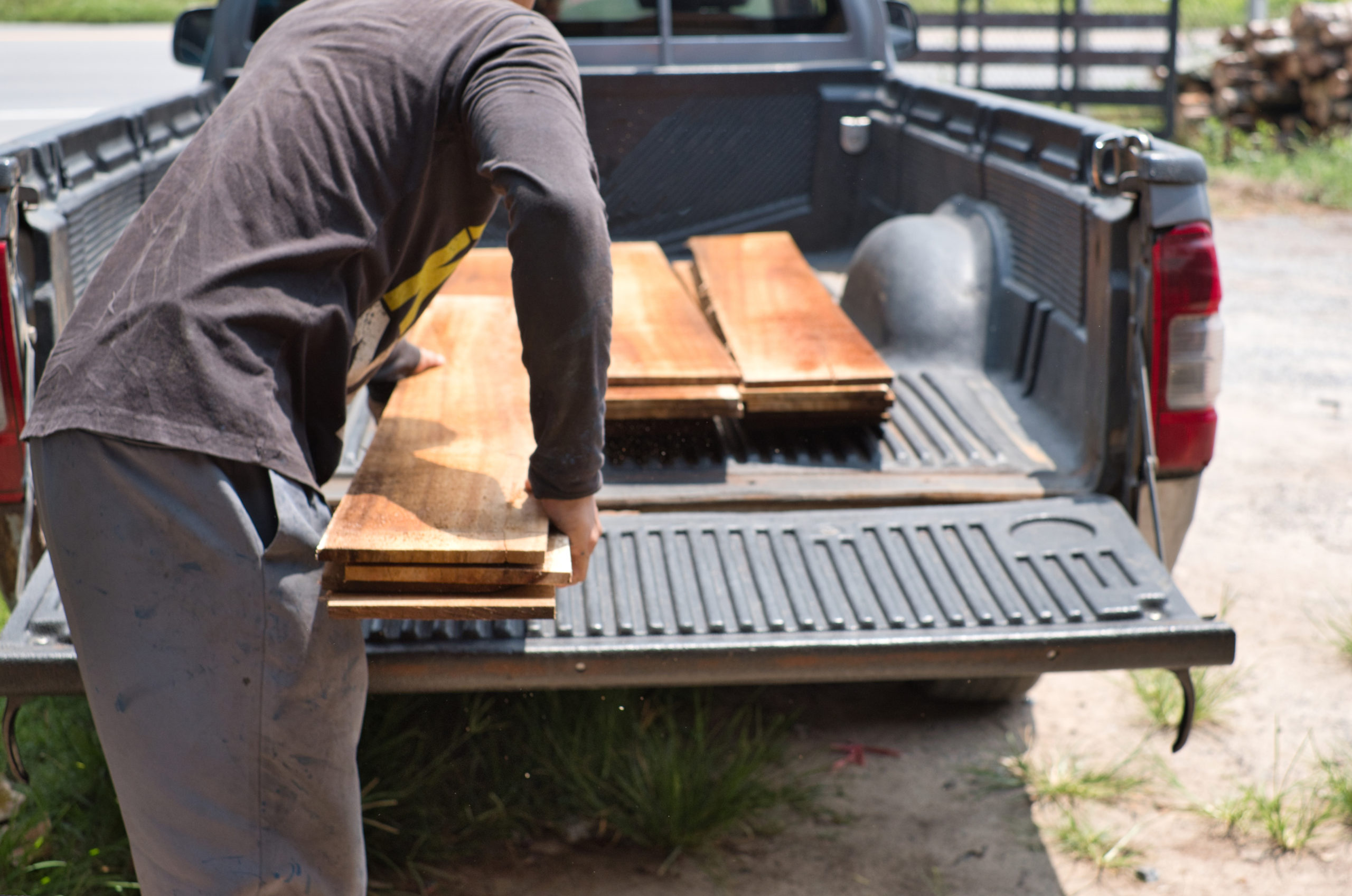How to Secure a Load Safely on Your Vehicle

Did you know that you’re held responsible if something falls off of your vehicle? If your unsecured load causes property damage, injuries and/or scatters debris and litter you can be ticketed, fined or even face a lawsuit. Currently the fine in Alberta for an unsecured load is between $345 and $500 but municipalities may have harsher penalties.
For the safety of the drivers around you, the environment and your pocketbook, it’s in your best interest to secure loads safely on your vehicle. This article will explain how to safely secure a load on your vehicle whether you’re using a truck bed, roof (with or without a roof rack) or trunk.
The Basics of How to Secure a Load Safely on Your Vehicle
Regardless of if you’re transporting a load on your vehicle’s roof, bed or trunk there are a few basic principles:
Your brake lights, signal lights and running lights must be kept visible.
If the view from your inside rearview mirror is blocked you must attach an outside rearview mirror to both sides of your vehicle.
If your load overhangs your vehicle, attach a red flag to the end of the load. If you’re driving at night, attach a red light instead.
Place lighter items at the bottom and any loose materials in a container or under a firmly secured tarp.
Use clingwrap for flimsy materials or bundles to help them stay together.
Use cargo netting or a tarp on top of your load to stop flyaways and make it easier to secure.
Use ratchet straps as they’re the most secure option. (Rope can be used if you know how to tie proper knots; bungee cords should only be used as an accessory as they aren’t secure enough to rely on).
Don’t overtighten the straps – they should be firm but not too tight.
Never attach a strap to a plastic part of your vehicle (including bumpers) – you should always attach to a metal point.
Always check your load by pushing and pulling on each individual item and adjust if necessary.
Stop and check the load after five to ten minutes of driving.
Stay in the right lane and follow the speed limit on highways; speed increases the risk of items shifting and possibly coming loose.
If you hear any whipping or rattling noises while driving, pull over and check your load. This can mean the straps have loosened or that your load isn’t fully secure.
Account for your new height, width and length dimensions while driving. Be extra cautious when turning, stopping, accelerating or going under bridges.
How to Secure a Load in a Truck Bed
A common mistake truck owners make is assuming if a load fits in the truck bed, it doesn’t need to be secured. Any load in the back of the truck can fall out, either due to a bump, sudden stop or acceleration, turn, or even the wind. It’s important to secure anything in your truck bed.
If the load is light and not too long, you can let it rest on the tailgate. However, you should still secure the load with at least two ratchet straps and mark the end with a red flag or light.
If the load is heavier and/or longer, you should lower the tailgate. Otherwise, you risk damaging the top of your truck. Heavier items should be placed as closest to the front as possible to prevent your truck from becoming too heavy in the back, which can cause steering and control difficulties.
Lay out two or more ratchet straps along the bottom of the truck bed and place the load on top. Secure the cargo by crisscrossing ratchet straps across and adding additional straps to the cab end, middle and far end. You may need to run straps from the anchor rings to the back edge of the load and down to the bumper.
You can secure lighter cargo using a cargo net and tarp – a tarp is also great for protecting it from the elements while driving. Cardboard can be used to protect the bed of your truck from scratches if it’s not coated.
Of course, exactly how you load and secure cargo in your truck bed depends on what you’re transporting. Don’t forget to check it by pushing and pulling each item before you head out on the road.
How to Secure a Load on Your Vehicle’s Roof
Not all vehicles are able to transport cargo on their roof. For example, if you have a convertible or soft roof, you should never use it to move anything. Check your vehicle’s manual to see how much weight your roof can support and know at least roughly how much your cargo weighs.
If You Have a Roof Rack
A roof rack makes it a lot faster and safer to transport a load on your vehicle’s roof. There are several types of racks so ensure you read your rack’s manual to ensure it’s installed and used correctly.
Certain racks are specifically designed for certain cargo such as kayaks, canoes, bikes or even pre-made containers. Simply follow the instructions on securing that cargo and double-check everything is secure.
Otherwise, here are some tips when using your roof rack to secure a load to your vehicle:
Be careful not to tighten ratchet straps so much so that you damage the racks.
Be mindful of weight limits for racks.
Secure the load for movement in all four directions (meaning at least four ratchet straps).
Stack items evenly across the roof front-to-back and between the doors.
Lighter items should go on the bottom with heavier items on top.
Cover the load with a tarp or netting.
If there’s any overhang or something that can catch a lot of wind (such as with a canoe or tree), you should secure the item to the car as well as to the rack (front, back and through the doors/windows).
Check the load is secure by pushing and pulling each item before you hit the road.
If You Don’t Have a Roof Rack
If you’re transporting something on a naked car, here are some tips:
Put a blanket or tarp on the bottom to protect your car and wrap the items in to prevent flyaways.
Centre your items in the middle of the vehicle (between the doors and front-to-back).
Lighter items should go on the bottom with heavier items on top.
You can wrap the ratchet straps through the window or through the doors – just remember that if you go through the window you’ll need to get into the vehicle to drive it (or have someone secure it while you’re inside). Simply pass the strap through the door or window of your vehicle and toss the straps over the item you’re trying to secure and tighten.
Some advise giving the strap a twist to keep the noise down and reduce the amount of force on the straps.
Use at least two ratchet straps through the front and rear side doors or windows of the vehicle. If your straps are long enough you can do multiple passes over the item and through your vehicle or use additional straps.
Ensuring the ratchet part of the straps are not inside the vehicle itself helps avoid bonking your head on them while you drive.
If there’s any overhang over the windshield and/or rear window, you must secure the item to the front and back of your vehicle. In the front, use the metal tow hooks or hood loop straps or anchors. In the rear, use the rear quick loop straps or hitch.
Check the load is secure by pushing and pulling on each individual item.
If You Lose Your Cargo on the Road
Here’s what to do if your load comes loose while on the road:
Slow down and pull over as soon as you’re able to. Put your hazards on!
Call 311 or 511. If the cargo is posing an immediate threat to other drivers, call 911.
It may not be safe to retrieve your cargo if it’s in the middle of the road. Wait until police or municipal officials arrive to help.
If the cargo isn’t in the road and it’s safe to do so, you can retrieve it.
If the loss of the load caused an accident (injury or property damage) you should phone the police and your insurance company.
Remember, you will be held responsible for an unsecured load on your vehicle. It can result in tickets, fines, and even a lawsuit if someone is hurt or has their property damaged. This can mean higher insurance rates and a lot of stress. Always take the time and effort to secure your cargo properly and double-check it.






